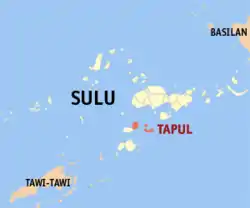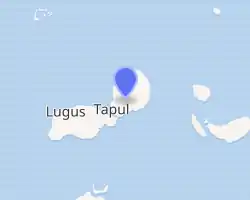Tapul
Tapul, officially the Municipality of Tapul (Tausūg: Dāira sin Tapul; Tagalog: Bayan ng Tapul), is a 5th class municipality in the province of Sulu, Philippines. According to the 2015 census, it has a population of 18,197 people. [3]
Tapul | |
|---|---|
| Municipality of Tapul | |
 Map of Sulu with Tapul highlighted | |
OpenStreetMap 
| |
.svg.png.webp) Tapul Location within the Philippines | |
| Coordinates: 5°43′00″N 120°54′00″E | |
| Country | |
| Region | Bangsamoro Autonomous Region in Muslim Mindanao (BARMM) |
| Province | Sulu |
| District | 2nd District |
| Barangays | 15 (see Barangays) |
| Government | |
| • Type | Sangguniang Bayan |
| • Mayor | Nasser T. Daud Jr. |
| • Vice Mayor | Nasser S. Daud |
| • Representative | Munir M. Arbison |
| • Electorate | 7,562 voters (2019) |
| Area | |
| • Total | 89.17 km2 (34.43 sq mi) |
| Elevation | 10 m (30 ft) |
| Highest elevation | 487 m (1,598 ft) |
| Lowest elevation | 0 m (0 ft) |
| Population | |
| • Total | 18,197 |
| • Density | 200/km2 (530/sq mi) |
| • Households | 3,123 |
| Economy | |
| • Income class | 5th municipal income class |
| • Poverty incidence | 48.58% (2015)[4] |
| • Revenue | ₱56,550,816.00 (2016) |
| Service provider | |
| • Electricity | Sulu Electric Cooperative |
| Time zone | UTC+8 (PST) |
| ZIP code | 7410 |
| PSGC | |
| IDD : area code | +63 (0)68 |
| Climate type | tropical climate |
| Native languages | Tausug Tagalog |
| Website | www |
Barangays
Tapul is politically subdivided into 15 barangays.
- Alu-Kabingaan
- Banting
- Hawan
- Kalang (Poblacion)
- Kamaunggi
- Kanaway
- Kanmangon
- Kaumpang
- Pagatpat
- Pangdan
- Puok
- Sayli
- Sumambat
- Tangkapaan
- Tulakan
Climate
| Climate data for Tapul, Sulu | |||||||||||||
|---|---|---|---|---|---|---|---|---|---|---|---|---|---|
| Month | Jan | Feb | Mar | Apr | May | Jun | Jul | Aug | Sep | Oct | Nov | Dec | Year |
| Average high °C (°F) | 27 (81) |
27 (81) |
28 (82) |
28 (82) |
29 (84) |
29 (84) |
28 (82) |
28 (82) |
28 (82) |
28 (82) |
28 (82) |
28 (82) |
28 (82) |
| Average low °C (°F) | 27 (81) |
27 (81) |
27 (81) |
27 (81) |
28 (82) |
28 (82) |
28 (82) |
28 (82) |
28 (82) |
28 (82) |
28 (82) |
27 (81) |
28 (82) |
| Average precipitation mm (inches) | 184 (7.2) |
143 (5.6) |
144 (5.7) |
136 (5.4) |
240 (9.4) |
301 (11.9) |
272 (10.7) |
253 (10.0) |
183 (7.2) |
265 (10.4) |
246 (9.7) |
208 (8.2) |
2,575 (101.4) |
| Average rainy days | 18.6 | 15.8 | 16.9 | 15.7 | 23.3 | 24.2 | 24.6 | 23.2 | 20.5 | 23.0 | 22.2 | 20.4 | 248.4 |
| Source: Meteoblue (modeled/calculated data, not measured locally)[5] | |||||||||||||
Demographics
|
| ||||||||||||||||||||||||||||||||||||||||||||||||
| Source: Philippine Statistics Authority [3] [6] [7] | |||||||||||||||||||||||||||||||||||||||||||||||||
References
- Municipality of Tapul | (DILG)
- "Province: Sulu". PSGC Interactive. Quezon City, Philippines: Philippine Statistics Authority. Retrieved 12 November 2016.
- Census of Population (2015). "ARMM – Autonomous Region in Muslim Mindanao". Total Population by Province, City, Municipality and Barangay. PSA. Retrieved 20 June 2016.
- https://psa.gov.ph/sites/default/files/City%20and%20Municipal-level%20Small%20Area%20Poverty%20Estimates_%202009%2C%202012%20and%202015_0.xlsx; publication date: 10 July 2019; publisher: Philippine Statistics Authority.
- "Tapul, Sulu : Average Temperatures and Rainfall". Meteoblue. Retrieved 31 January 2019.
- Census of Population and Housing (2010). "ARMM – Autonomous Region in Muslim Mindanao". Total Population by Province, City, Municipality and Barangay. NSO. Retrieved 29 June 2016.
- Censuses of Population (1903–2007). "ARMM – Autonomous Region in Muslim Mindanao". Table 1. Population Enumerated in Various Censuses by Province/Highly Urbanized City: 1903 to 2007. NSO.
- "Poverty incidence (PI):". Philippine Statistics Authority. Retrieved 28 December 2020.
- https://psa.gov.ph/sites/default/files/NSCB_LocalPovertyPhilippines_0.pdf; publication date: 29 November 2005; publisher: Philippine Statistics Authority.
- https://psa.gov.ph/sites/default/files/2003%20SAE%20of%20poverty%20%28Full%20Report%29_1.pdf; publication date: 23 March 2009; publisher: Philippine Statistics Authority.
- https://psa.gov.ph/sites/default/files/2006%20and%202009%20City%20and%20Municipal%20Level%20Poverty%20Estimates_0_1.pdf; publication date: 3 August 2012; publisher: Philippine Statistics Authority.
- https://psa.gov.ph/sites/default/files/2012%20Municipal%20and%20City%20Level%20Poverty%20Estima7tes%20Publication%20%281%29.pdf; publication date: 31 May 2016; publisher: Philippine Statistics Authority.
- https://psa.gov.ph/sites/default/files/City%20and%20Municipal-level%20Small%20Area%20Poverty%20Estimates_%202009%2C%202012%20and%202015_0.xlsx; publication date: 10 July 2019; publisher: Philippine Statistics Authority.
External links
- Tapul Profile at PhilAtlas.com
- Philippine Standard Geographic Code
- Philippine Census Information
- Local Governance Performance Management System
This article is issued from Wikipedia. The text is licensed under Creative Commons - Attribution - Sharealike. Additional terms may apply for the media files.
